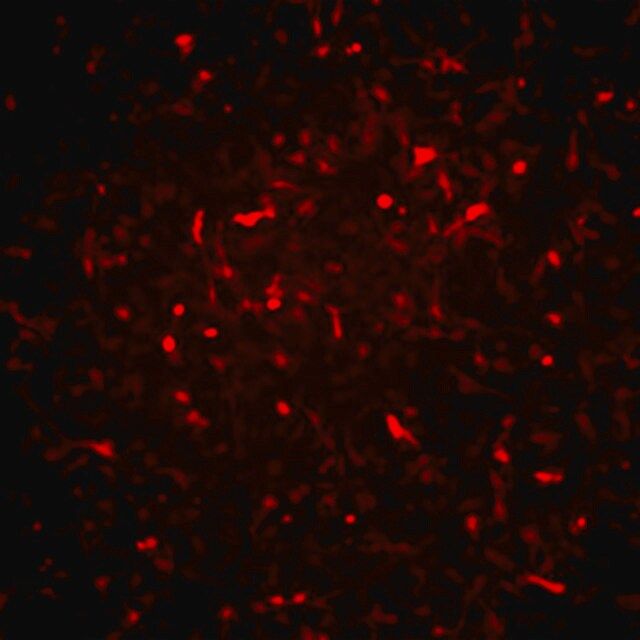您的位置:首页 > 产品中心 > Alzheimer′s In A DishTM PSEN1-RFP Lentivirus
Alzheimer′s In A DishTM PSEN1-RFP Lentivirus

| 产品编号: | 4095087 |
| 规格: | The PSEN1-RFP lentivirus can be used to generate 3D cell culture models of Alzheimer’s Disease. The high-titer polycistronic lentiviral particles contain the PSEN1 and TagRFP2 proteins and can be used to infect human neural stem cells at high effici |
| 包装规格: | 15 μL |
| 产品类别: | 进口试剂 |
| 品牌: | Sigma-Aldrich |
| 优惠价: | 立即咨询 |
产品别名
Alzheimer′s In A DishTM PSEN1-RFP Lentivirus
PSEN1-RFP, ReNcell 3D Alzheimers Model, ADID 3D Neural Cell Model
基本信息
| eCl@ss | 32161000 |
| General description【一般描述】 | Amyloid-beta plagues and neurofibrillary tangles are key pathological features observed in the brains of Alzheimer′s patients. Familial, early onset forms of AD (FAD) are caused by autosomal dominant inherited genetic mutations and offer an opportunity to study the effects of key mutations on the diseases progression and pathology. To date, approximately 200 FAD mutations in APP and/or PSEN1 have been reported. Transgenic mouse models and human neurons harboring FAD mutations in PSEN-1 and/or APP are widely used as model systems and have provide important insights into the disease. Transgenic mouse models are able to recapitulate the loss in cognitive functions along with increased deposition of b-amyloid plagues, but are unable to demonstrate neurofibrillary tangles, one of the key pathological hallmarks of AD. Similarly human iPSC-derived neurons from FAD patients demonstrated increased levels of the pathogenic AB species and phosphorylated tau, but lack the characteristic amyloid-beta plagues and neurofibrillary tangles. Recently a 3D model using genetically engineered human neural stem cells that overexpress FAD mutations was reported to recapitulate the two pathological hallmarks of AD: b-amyloid plagues and neurofibrillary tangles. Lentiviruses expressing FAD mutations in human APP with both the K670N/M671L (Swedish) and V717I (London) mutations (APPSL) and/or PSEN1 with the E9 mutation (PSEN1(E9)) and APPSL/PSEN1(E9) along with fluorescent proteins as reporters for viral infection (see below), were used to transfect ReNcell VM human neural stem cells. FACS was utilized to enrich for cells with the highest transgene expressions followed by encapsulation of the sorted cells in a 3D Matrigel culture system. After approximately 6 weeks of differentiation, aggregation of AB was observed. Robust accumulation of phosphorylated tau along neurofibrillary tangles was readily detectable after 10-14 weeks. The Alzheimer′s In A Dish<TMSYMBOL></TMSYMBOL> PSEN1-RFP Lentivirus is a necessary reagent to set up the Alzheimer′s 3D culture system. The lentivirus contains the PSEN1 FAD mutations and can be used to infect human neural cells. The RFP tag enables assessment of viral infectivity and allows FACS sorting of the highest expressing cells. |
| Application【应用】 | Research Category Stem Cell Research Neuroscience |
| Components【组分】 | PSEN1-RFP Alzheimer’s Lentivirus: (Part No. CS222746) One (1) vial containing 15 µL of high titer lentiviral particles. Store at -80°C. Note: For exact viral titer, refer to the label on the vial. |
| Quality【质量】 | The packaged lentivector constructs are provided as frozen VSV-G pseudotyped viral particles. The titer (ifus/ml) is defined by SBI’s Global UltraRapid Lentiviral Titer Kit (Cat. # LV961A-1) in HT1080 cells transduced by the packaged constructs. |
| Legal Information【法律信息】 | Alzheimer′s in a Dish is a trademark of The General Hospital Corporation |
产品性质
| Quality Level【质量水平】 | 100 |
| species reactivity | human |
| technique(s) | cell culture | mammalian: suitable cell culture | stem cell: suitable cell differentiation: suitable |
产品说明
| Storage and Stability【储存及稳定性】 | Storage and Handling Lentivirus is stable for at least 6 months when stored at -80°C. After first thaw, place immediately on ice and store in working aliquots to avoid further freeze thaws. Avoid freeze thaws as this will result in a decrease in the virus titer. Important Safety Note: • Replication-defective lentiviral vectors are not known to cause any diseases in humans or animals. However, lentiviruses can integrate into the host cell genome and thus pose some risk of insertional mutagenesis. • Wear gloves when using this product. Avoid skin contact or ingestion of all reagents and chemicals used in this protocol. • Lentivirus is a risk group 2 and should be handled under approved Biosafety Level 2 (BSL2) controls. |
安全信息
| Storage Class Code【储存分类代码】 | 10 - Combustible liquids |




